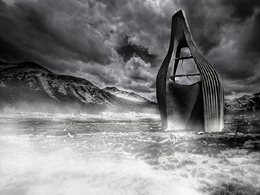STUDENTS PROJECTS
PROJECTS2013

22 May, 2014
Life After ISON / population: UNKNOWN
The concept is based on the research of two Belarusian astrophysics who discovered a comet named ISON heading for planet Earth, months before NASA did.
Students: Mirtsopoulos Ioannis, Stroponiatis Vasilis
Supervisor: Papakostas Georgios
Aristotle University of Thessaloniki. Faculty of Engineering, School of Architecture
Presentation date: July 2013
The concept is based on the research of two Belarusian astrophysics who discovered a comet named ISON heading for planet Earth, months before NASA did. This project aims to design the way humanity could survive one such disaster. Extensive research was made before, looking for the optimum site to construct disaster habitats. Taking into consideration the effects of a collision between Earth and a comet of 5 to 6 kilometers diameter, the best place to host the population survived is a global network of underground shelters.
According to scientific statements related to the climate conditions after such a collision, it is expected that oxygen levels will be decreased due to the blast that will cover atmosphere. Subsequently, life continuation and sunlight on the surface of Earth will be doubtful and limited respectively. Toxic and acid gases will be released from abandoned industries that will contaminate air, water and ground. Electricity stock will be consumed and regardless of the high demand, energy will be missing.
Inspired by the trees' roots, each habitat is developed vertically and multiple branches create the desired network which hosts all residences. Vertical axes allow communication and transportation among all the levels of each shelter and at the same time provide the interior which natural light through skylights built at their upper edge.

The very core of each shelter is a high rise structure stretching for many meters above ground. It has multiple functions and symbolisms, signifying the whole construction.

Above all, it acts as a monument for next generations, witnessing the existence of human shelters underground, as the main entrance, for the very last time people run to the shelters, and as energy provider due to the integrated wind turbines.
Survival is closely linked to human collaboration and ideas exchange between the occupants of either each shelter or different ones. That is why activities such as gatherings promoting democracy have affected the overall design.

For purposes of networking each shelter includes a terminal which allows transportation to other shelters many kilometers far.



In terms of design, at the underground part of the shelters, archetypal forms and materials are used in a modern way, bringing back memories of our ancestors in caves. Such places of collectivism and socialization were of utmost importance for humanity during every kind of disaster.

The structure above ground is addressed to fulfill multiple symbolisms and evoke more memories. Life cannot be taken for granted and women-mothers are the only chance of humanity to survive. Thus, woman's body is used as a reference point for the design of the high rise structure which mainly satisfies people's greatest desire, life.













